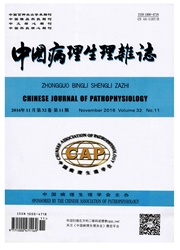

 中文摘要:
中文摘要:
目的:探讨开放ATP敏感性钾通道(K_(ATP)通道)能否抑制Toll样受体4(TLR4)/核因子-κB(NF-κB)通路对抗高糖(HG)引起的H9c2心肌细胞损伤和炎症。方法:应用Western blot测定TLR4和NF-κB p65的蛋白水平;应用ELISA法检测细胞培养液中白细胞介素-1β(IL-1β)和肿瘤坏死因子-α(TNF-α)的水平;采用细胞计数试剂盒8(CCK-8)测定心肌细胞存活率;罗丹明123染色荧光显微镜照相法测定线粒体膜电位(MMP);双氯荧光素染色荧光显微镜照相法测定细胞内活性氧簇(ROS)水平;Hoechst 33258核染色荧光显微镜照相法检测凋亡细胞数量。结果:H9c2心肌细胞经HG(35 mmol/L葡萄糖)处理24 h,胞内TLR4和磷酸化NF-κB p65(p-NF-κB p65)的蛋白水平明显增加,100μmol/L K_(ATP)通道开放剂二氮嗪(DZ)预处理30 min可抑制HG对TLR4和p-NF-κB p65蛋白水平的上调作用;此外,30μmol/L TAK-242(TLR4抑制剂)和HG共处理心肌细胞24 h也可减轻HG对p-NF-κB p65的上调作用。另一方面,100μmol/L DZ预处理有明确的心肌保护作用,可抑制HG引起的细胞毒性、炎症反应、线粒体损伤、氧化应激和细胞凋亡,使细胞存活率升高,并减少IL-1β和TNF-α分泌水平、MMP丢失、ROS生成及凋亡细胞数量;而30μmol/L TAK-242或100μmol/L PDTC(NF-κB抑制剂)共处理心肌细胞24 h也可发挥和DZ相类似的作用,能抑制HG引起的上述损伤和炎症反应。结论:开放K_(ATP)通道可通过抑制TLR4/NF-κB通路对抗HG引起的H9c2肌细胞损伤和炎症。
 英文摘要:
英文摘要:
AIM: To investigate whether the opening of ATP-sensitive K~+( K_(ATP)) channels protects H9c2 cardiac cells against high glucose( HG)-induced injury and inflammation by inhibiting the Toll-like receptor 4( TLR4)/nuclear factor-κB( NF-κB) pathway. METHODS: The protein levels of TLR4 and NF-κB p65 were determined by Western blot. The levels of interleukin-1β( IL-1β) and tumor necrosis factor-α( TNF-α) were detected by ELISA. The cell viability was measured by CCK-8 assay. Mitochondrial membrane potential( MMP) was examined by rhodamine 123( Rh 123)staining followed by photofluorography. The intracellular levels of reactive oxygen species( ROS) were detected by 2',7'-dichlorfluorescein- diacetate( DCFH-DA) staining followed by photofluorography. The number of apoptotic cells was observed by Hoechst 33258 nuclear staining followed by photofluorography. RESULTS: After the H9c2 cardiac cells were treated with HG( 35 mmol/L glucose) for 24 h,the protein levels of TLR4 and phosphorylated NF-κB p65( p-NF-κB p65) were significantly increased. Pretreatment of the cells with 100 μmol/L diazoxide( DZ,a K_(ATP)channel opener) for30 min before exposure to HG considerably blocked the up-regulation of the TLR4 and p-NF-κB protein levels induced by HG. Moreover,co-treatment of the cells with 30 μmol/L TAK-242( an inhibitor of TLR4) obviously inhibited the HG-induced up-regulation of the p-NF-κB p65 protein level. On the other hand,pretreatment of the cells with 100 μmol/L DZ had a clear myocardial protection effect,which attenuated the HG-induced cytotoxicity,inflammatory response,mitochondrial damage,oxidative stress and apoptosis,evidenced by an increase in the cell viability,and decreases in the levels of IL-1β and TNF-α,MMP loss,ROS generation and the number of apoptotic cells. Similarly,co-treatment of H9c2 cardiac cells with 30 μmol/L TAK-242 or 100 μmol/L PDTC( an inhibitor of NF-κB) and HG for 24 h also obviously reduced the
 同期刊论文项目
同期刊论文项目
 同项目期刊论文
同项目期刊论文
 期刊信息
期刊信息
